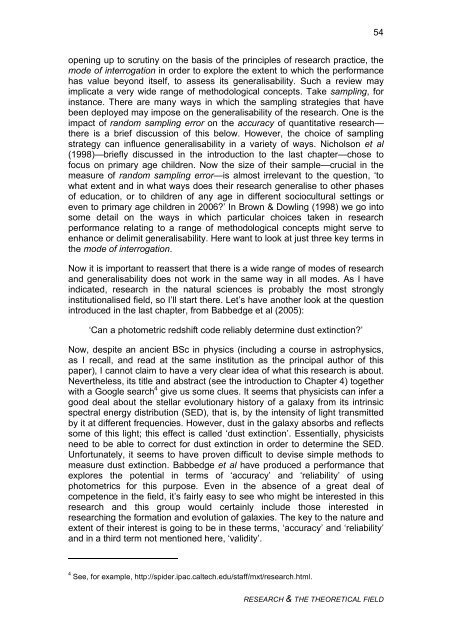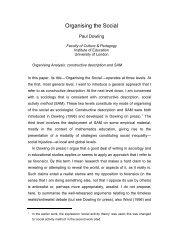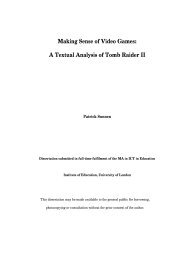Research and the Theoretical Field - Pauldowling.me
Research and the Theoretical Field - Pauldowling.me
Research and the Theoretical Field - Pauldowling.me
You also want an ePaper? Increase the reach of your titles
YUMPU automatically turns print PDFs into web optimized ePapers that Google loves.
54<br />
opening up to scrutiny on <strong>the</strong> basis of <strong>the</strong> principles of research practice, <strong>the</strong><br />
mode of interrogation in order to explore <strong>the</strong> extent to which <strong>the</strong> performance<br />
has value beyond itself, to assess its generalisability. Such a review may<br />
implicate a very wide range of <strong>me</strong>thodological concepts. Take sampling, for<br />
instance. There are many ways in which <strong>the</strong> sampling strategies that have<br />
been deployed may impose on <strong>the</strong> generalisability of <strong>the</strong> research. One is <strong>the</strong><br />
impact of r<strong>and</strong>om sampling error on <strong>the</strong> accuracy of quantitative research—<br />
<strong>the</strong>re is a brief discussion of this below. However, <strong>the</strong> choice of sampling<br />
strategy can influence generalisability in a variety of ways. Nicholson et al<br />
(1998)—briefly discussed in <strong>the</strong> introduction to <strong>the</strong> last chapter—chose to<br />
focus on primary age children. Now <strong>the</strong> size of <strong>the</strong>ir sample—crucial in <strong>the</strong><br />
<strong>me</strong>asure of r<strong>and</strong>om sampling error—is almost irrelevant to <strong>the</strong> question, ‘to<br />
what extent <strong>and</strong> in what ways does <strong>the</strong>ir research generalise to o<strong>the</strong>r phases<br />
of education, or to children of any age in different sociocultural settings or<br />
even to primary age children in 2006’ In Brown & Dowling (1998) we go into<br />
so<strong>me</strong> detail on <strong>the</strong> ways in which particular choices taken in research<br />
performance relating to a range of <strong>me</strong>thodological concepts might serve to<br />
enhance or delimit generalisability. Here want to look at just three key terms in<br />
<strong>the</strong> mode of interrogation.<br />
Now it is important to reassert that <strong>the</strong>re is a wide range of modes of research<br />
<strong>and</strong> generalisability does not work in <strong>the</strong> sa<strong>me</strong> way in all modes. As I have<br />
indicated, research in <strong>the</strong> natural sciences is probably <strong>the</strong> most strongly<br />
institutionalised field, so I’ll start <strong>the</strong>re. Let’s have ano<strong>the</strong>r look at <strong>the</strong> question<br />
introduced in <strong>the</strong> last chapter, from Babbedge et al (2005):<br />
‘Can a photo<strong>me</strong>tric redshift code reliably determine dust extinction’<br />
Now, despite an ancient BSc in physics (including a course in astrophysics,<br />
as I recall, <strong>and</strong> read at <strong>the</strong> sa<strong>me</strong> institution as <strong>the</strong> principal author of this<br />
paper), I cannot claim to have a very clear idea of what this research is about.<br />
Never<strong>the</strong>less, its title <strong>and</strong> abstract (see <strong>the</strong> introduction to Chapter 4) toge<strong>the</strong>r<br />
with a Google search 4 give us so<strong>me</strong> clues. It seems that physicists can infer a<br />
good deal about <strong>the</strong> stellar evolutionary history of a galaxy from its intrinsic<br />
spectral energy distribution (SED), that is, by <strong>the</strong> intensity of light transmitted<br />
by it at different frequencies. However, dust in <strong>the</strong> galaxy absorbs <strong>and</strong> reflects<br />
so<strong>me</strong> of this light; this effect is called ‘dust extinction’. Essentially, physicists<br />
need to be able to correct for dust extinction in order to determine <strong>the</strong> SED.<br />
Unfortunately, it seems to have proven difficult to devise simple <strong>me</strong>thods to<br />
<strong>me</strong>asure dust extinction. Babbedge et al have produced a performance that<br />
explores <strong>the</strong> potential in terms of ‘accuracy’ <strong>and</strong> ‘reliability’ of using<br />
photo<strong>me</strong>trics for this purpose. Even in <strong>the</strong> absence of a great deal of<br />
competence in <strong>the</strong> field, it’s fairly easy to see who might be interested in this<br />
research <strong>and</strong> this group would certainly include those interested in<br />
researching <strong>the</strong> formation <strong>and</strong> evolution of galaxies. The key to <strong>the</strong> nature <strong>and</strong><br />
extent of <strong>the</strong>ir interest is going to be in <strong>the</strong>se terms, ‘accuracy’ <strong>and</strong> ‘reliability’<br />
<strong>and</strong> in a third term not <strong>me</strong>ntioned here, ‘validity’.<br />
4 See, for example, http://spider.ipac.caltech.edu/staff/mxt/research.html.<br />
RESEARCH & THE THEORETICAL FIELD




